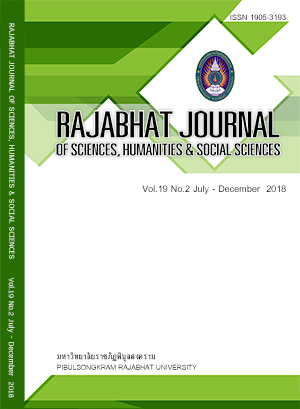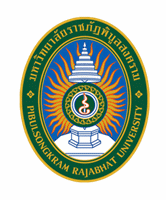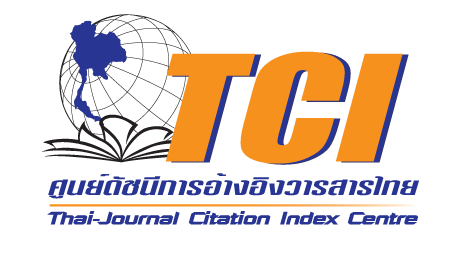ความชุกและการระบุชนิดพยาธิใบไม้ Echinostoma revolutum ด้วย ND1 ในระยะเมตาเซอร์คาเรียและตัวเต็มวัย จากจังหวัดลำพูนและลำปางของประเทศไทย
คำสำคัญ:
หอยขม, Echinostoma revolutum, ลำพูน, ลำปาง, ยีนไมโทคอนเตรียบทคัดย่อ
ระยะเมตาเซอร์คาเรียเป็นระยะติดต่อของพยาธิใบไม้กลุ่ม echinostome ที่สามารถพบได้ในหอยน้ำจืด ลูกอ๊อดและปลา การศึกษาครั้งนี้ทำการเก็บเมตาเซอร์คาเรียในหอยขม Filopaludina จำนวน 3 ชนิด คือ Filopaludina martensi martensi, F. dorliaris และ F. sumatrensis polygramma จาก 4 อำเภอของจังหวัดลำพูนและลำปาง พบค่าความชุกของการติดพยาธิเท่ากับ ร้อยละ 27.05, 41.92 และ 48.05 ตามลำดับ นำตัวเต็มตัวที่ได้หลังจากการป้อนเมตาเซอร์คาเรียให้หนูแฮมเตอร์และลูกไก่ 14 วันมาระบุชนิดโดยการศึกษาลักษณะวิทยาภายใต้กล้องจุลทรรศน์แบบใช้แสงและกล้องจุลทรรศน์อิเล็กตรอน ร่วมกับเทคนิคทางอณูชีววิทยาโดยศึกษา Phylogenetic tree จากยีนไมโทคอนเตรียในตำแหน่ง ND1 (nicotinamide adenine dinucleotide dehydrogenase subunit 1) ตัวเต็มวัยของพยาธิที่พบมีลักษณะลำตัวยาว ส่วนท้องโค้งงอ head collar มี collar spines จำนวน 37 อัน และ testes มีรูปร่าง 2 แบบคือแบบ lobe และแบบกลม อย่างไรก็ตามการระบุชนิดได้พิจารณาจากลักษณะสัณฐานวิทยา การวัดทางสัณฐานและ phylogenetic tree จาก ND1 โดยสามารถระบุชนิดพยาธิที่พบเป็น Echinostoma revolutum ซึ่งมีหอยขม Fliopaludina spp. เป็นโฮสต์กึ่งกลางตามธรรมชาติ และเป็นการยืนยันว่ามีการระบาดของพยาธิชนิดนี้ในจังหวัดลำพูนและลำปาง
เอกสารอ้างอิง
Chantima K, Chai JK, Wongsawad C. Echinostoma revolutum freshwater snails as the second intermediate hosts in Chiang Mai, Thailand, The Korean Journal of Parasitology. 2013: 183-189.
Chantima K. Epidemiology, Life History and Molecular Identification of Trematodes, Echinostoma spp. In Chiang Mai province.Doctor of Philosophy in Biology and Ethnobiology, Faculty of Science, Chiang Mai University, 2014.
Chai JY. Echinostomes in humans. In Fried B, Toledo R eds. The biology of Echinostomes from the molecule to the community. New York, USA: Springer Science Business Media LLC, 2009.
Chai JY, Sohn WM, Na BK. et al. Echinostoma revolutum metacercariae in Filopaludina snails from Nam Dinh Province, Vietnam, and adults from experimental hamsters, The Korean Journal of Parasitology.2011; 49(4): 449-455.
Chai JY, Sohn WM, Yong TS. et al. Echinostome flukes receovered from humans in Khammouane Province, Lao PDR, The Korean Journal of Parasitology. 2012; 50(3): 269-272.
Georgieva S, Faltynkova A, Brown R. et al. Echinostoma 'revolutum' (Digenea: Echinostomatidae) species complex revisited: species delimitation based on novel molecular and morphological data gathered in Europe, Parasite and vectors. 2014; 7: 520.
Khanna V, Tilak K, Mukim Y, Khanna R. An unusual case of Echinostomiasis in a retropositive patient: A case report, Human Parasitic Diseases. 2016; 8: 43–45.
Lee SK, Chung NS, Lo IH.et al.Two case of human infection by Echinostoma hortense,The Korean Journal of Parasitology.1986; 24(1): 77-81.
LeeKJ, Bae YT, Kim DH.et al. Status of intestinal parasites infection among primary school children in Kampongcham, Cambodia, The Korean Journal of Parasitology. 2002; 40(3): 153-155.
Margolis L, Esch GW, Holmes JC. et al. The use of ecological terms in parasitology (report of an ad hoc committee of the American society of parasitologists), Journal of Parasitology. 1982; 68(1): 131–133.
Morgan JAT, Blair D. Relative merits of nuclear ribosomal internal transcribed spacers and mitochondrial CO1 and ND1 genes for distinguishing among Echinostoma species (Trematoda). Parasitology. 1998; 116(3): 289-297.
Morgan JA, Blair D. Mitochondrial ND1 gene sequences used to identify echinostome isolates from Australia and New Zealand. 1998; 28(3): 493-502.
Nagataki M, Tantrawatpan C, Agatsuma T. et al. Mitochondrial DNA sequences of 37 collar-spinedechinostomes (Digenea: Echinostomatidae) in Thailand and Lao PDR reveals presence of two species: Echinostoma revolutum and E. miyagawai, Infection, Genetics and Evolution. 2015; 35: 56–62.
Noikong W, Wongsawad C. Epidemiology and molecular genotyping of echinostome metacercariae in Filopaludina snails in Lamphun Province, Thailand, Asian Pacific Journal of Tropical Medicine. 2014; 7(1): 26-29.
Noikong W, Wongsawad C, Chai JY. et al. Molecular analysis of Echinostome metacercariae from their second intermediate host found in a localised geographic region reveals genetic heterogeneity and possible cryptic speciation, PLOS Neglected Tropical Diseases. 2014; 8(4): 1-7.
Park SK, Kim DH, Deung YK. et al. Status of intestinal parasite infections among children in Bat Dambang, Cambodia,The Korean Journal of Parasitology. 2004; 42(4): 201-203.
Saijuntha W, Sithithaworn P, Duenngai K. et al. Genetic variation and relationships of four species of medically important echinostomes (Trematoda: Echinostomatidae) in South-East Asia, Infection Genetics and Evolution. 2011; 11: 375–381.
Sohn WM, Kim HJ, Yong TS. et al. Echinostoma ilocanum infection in Oddar Meanchey province, Cambodia, The Korean Journal of Parasitology. 2012; 49(2): 187-190.
ดาวน์โหลด
เผยแพร่แล้ว
รูปแบบการอ้างอิง
ฉบับ
ประเภทบทความ
สัญญาอนุญาต
Each article is copyrighted © by its author(s) and is published under license from the author(s).










